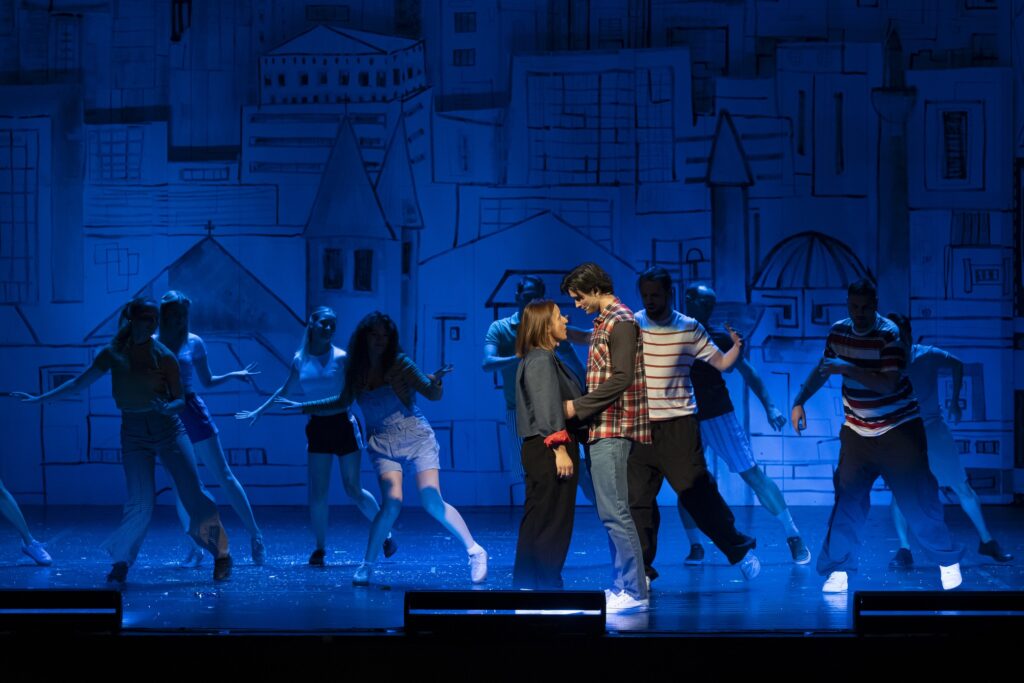National Theatre Sarajevo, premiere 22nd October 2025
Imagine a city’s skyline as a musical score. Take any city. The peaks of its buildings, with their ups and downs, define the highs and lows of the notes, while their forms determine the rhythmic values. The tempo is set by all its moving elements — the people, the animals, the cars, even the wind that pushes clouds across the sky. Rests mark the pauses where silence falls, when the pulse of the city grows too loud and heavy, forcing a breath in between day and night time. What would it sound like?
The soundscape of Sarajevo has found its embodiment in Sarajevo, My Dear — the first-ever Bosnian-Herzegovinian musical. Since its premiere, the production has been breaking records one after another. By bringing together some of the most influential voices of the local music scene, including singer/songwriter Zlatan Fazlić Fazla (libretto and composition) and legendary conductor Ranko Rihtman, and featuring the Sarajevo Philharmonic Orchestra, it has stirred immense enthusiasm among audiences — to the extent that every single performance through the end of the calendar year has already sold out.
Dino Mustafić, artistic director of National Theatre Sarajevo and director of this production, promotes Sarajevo, My Dear as a collaborative manifesto that celebrates the richness of the local musical scene. According to him, “Sarajevo’s music has always been recognizable for its blend of melancholy and cheerfulness, for the ironic smile that conceals pain, and for the persistence in finding a melody even in the most difficult moments.”
While his directional approach seems intended to convey this paradoxical formula, using music as both a lens and a medium to explore collective identity and memory, the dramaturgy of the evening (Adnan Lugonić) takes a different path. Instead of inviting an active search for self-understanding, the audience is met with a familiar narrative — one steeped in Yugonostalgia.

Sarajevo, Moje Drago
By looking back to the (g-) olden days of former Yugoslavia, the story traces the life of a Sarajevo mahala (neighbourhood) from the 1970s to a vague and uncertain present. Rather than centring on a single protagonist, Fazlić chooses to follow a dozen characters — mostly young couples who grow into responsible members of a socialist society, embodying the communal spirit of the time. This collective focus allows for a broad palette of characters, but, at the same time, only scratches the surface of their (human) experience, resulting in a loss of individual depth. At moments, the people presented on stage seem less like reflections of real life and more like representations of an outdated semantic system. What emerges are not universal emotions, but impersonal symbols.
Historically, it encompasses key moments such as the death of Tito, the 1984 Winter Olympic Games, and the siege of Sarajevo from 1992 to 1995. Politically, it moves from the period of socialist prosperity through the disintegration of Yugoslavia to a subtle critique of Sarajevo’s current condition, expressed through the choral singing and the recurring question: “Where are our children?” Emotionally, the musical mourns the loss of community — a value once at the very heart of the city’s self-image — as well as the disappearance of the country’s youth, who continue to leave in search of better lives abroad, fleeing mainly from economic hardship and political instability.
The war marks a profound historical rupture and a pivotal peripeteia in the dramaturgy, making the production feel almost like two separate pieces, or: like day and night — before and after intermission. This division is reinforced visually, too: costumes (Vanja Ciraj) and lighting trace the passage of time, with a yellowish dreamy palette marking the 1970s and 1980s, gradually giving way to colder, darker tones. By the second half, black and blue dominate, symbolizing mourning and the weight of loss. The backdrop remains constant, however, with Sarajevo’s skyline rendered in stark black and white, resembling a handwritten musical score. The cityscape, beautifully designed by Osman Arslanagić, is enriched by the minarets of elegant mosques, the bell towers of the Sacred Heart Cathedral, and the geometric lines of socialistic skyscrapers, creating a layered and evocative portrait of the city.
Rather than exploring the complex paradox that Mustafić describes so vividly as the city’s “blend of melancholy and cheerfulness,” the dramaturgy presents a stark juxtaposition of opposites, giving the impression that they cannot coexist: one belongs entirely to the past, the other to the present. In doing so, Sarajevo, My Dear reinforces a sentimentality that, while understandable, is self-affirming and backward-looking, largely ignoring the perspectives of younger generations who are less affected by the so-called Yugonostalgia.
Nevertheless, the musical palette of the production, especially in its first half, demonstrates remarkable stylistic breadth, reflecting both Fazla’s and Rihtman’s versatile artistic backgrounds. The score navigates effortlessly through jazz, pop, and rock, providing ample space for the performers to showcase their diverse talents. Led by Rihtman, the Sarajevo Philharmonic Orchestra impresses with virtuosic precision, anchoring the production in its recurring theme of togetherness and communal spirit. Together with the ensemble on stage, they serve as the driving force behind the production’s central theme of community.

Sarajevo, Moje Drago
The ensemble itself spans a wide range of experience, bringing together established names such as Ermin Bravo, Mirvad Kurić, and Aleksandar Seksan, alongside promising young talents like Lejla Hakalović, Issa Osmić, Iman Bubić, and Iva Prgić, who are either completing or have recently completed their studies at the Academy of Performing Arts in Sarajevo. These young performers impress with remarkable vocal and physical agility, leaving one to hope that the future of Sarajevo’s theatre will include more productions in the genre of musical theatre. In addition to the actors and actresses, the production features members of the in-house Ballet and Opera Choir, as well as dancers from the youth company Fresh Generation.
While Sarajevo, My Dear captivates through its musical richness and collective energy, it ultimately dwells in the semantics of sentimentality. Beneath its spectacle lies a narrative that praises the past and condemns the present, reaffirming familiar emotions rather than questioning them, celebrating community while hesitating to consider what that community might mean for future generations.
Credits
Director: Dino Mustafić//Libretto: Zlatan Fazlić//Composer and conductor: Ranko Rihtman//Dramaturgy and adaptation of libretto: Adnan Lugonić//Musical director: Lejla Jusić//Set design: Osman Arslanagić//Costume design: Vanja Ciraj//Choreographer: Amila Terzimehić//Assistant to choreographer: Dženita Hasečić//Opera choir director: Daniel Žontar//Light Design: Moamer Saković//Sound Design: Borjan Milošević
Cast: Ermin Bravo, Aldin Omerović, Nikolina Vujić, Andrea Aković, Sanjin Arnautović, Nedim Šuvalija, Haris Bidžan, Issa Osmić, Armin Omerović, Marko Mirković, Alen Hadžić, Franko Bralo, Tarik Mulaomerović, Anastasija Dunjić, Iva Prgić, Sara Seksan, Mediha Musliović, Vedrana Božinović, Aleksandar Seksan, Izudin Bajrović, Mirvad Kurić, Iman Bubić, Mona Muratović, Lejla Hakalović, Merima Lepić Redžepović, Rijad Ljutović together with the Sarajevo Philharmonic Orchestra, Ballet and Opera Choir NPS, backing band and dance company Fresh Generation
For more information, visit: nps.ba
Berina Musa is a writer, dramaturg, and critic based in Sarajevo and Freiburg. She studied German linguistics, literary studies, and art history at the University of Freiburg and is currently completing a second degree in dramaturgy at the Academy of Performing Arts in Sarajevo. Her plays and short films have been presented at the Bosnian National Theatre Zenica, MESS, the Sarajevo Film Festival, and the Mostra Internazionale del Nuovo Cinema di Pesaro.








